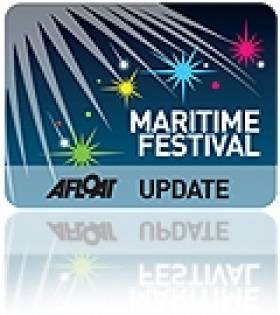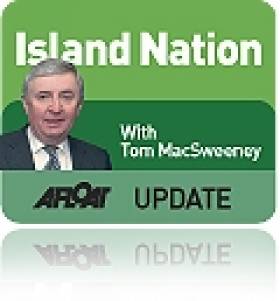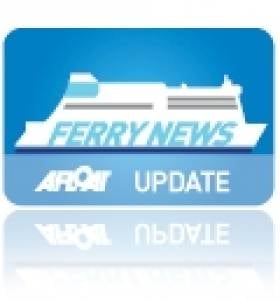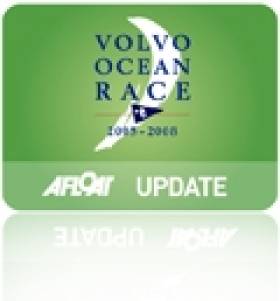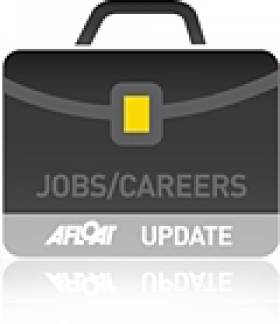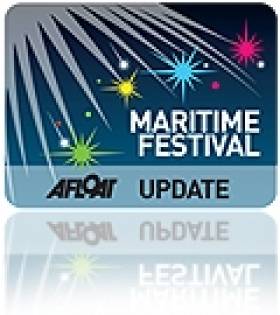Displaying items by tag: maritime
#ISLANDNATION – What the first woman Chief Executive of Irish Lights thinks about the Irish marine sphere; the first vessel of its kind built in Castletownbere; remembering Kinsale's Mario; China's oldest vessel; an 18th century Russian sailing ship takes to the seas again; decent onboard conditions for fishermen and the greatest maritime disaster ever. All these and more on tomorrow morning's edition of THIS ISLAND NATION on afloat.ie
#MARITIMEFESTIVALS – Rosses Point in County Sligo is hosting its third International Shanty and Seafaring Festival from the 15th – 17th June 2012.The launch of the festival takes place on Thursday 31st of May in the Yeats County Hotel, Rosses Point.
“The festival is a celebration of the long maritime tradition of Rosses Point and Sligo area” stated Willie Murphy, chairperson of the festival committee.
“Shanties were working songs used on board sailing ships. The songs were mostly sung when the job involved several crew members working in rhythm together.With many international and local groups performing “songs of the sea” this festival helps to preserve the seafaring tradition here in Rosses Point.
The Festival is run in aid of the RNLI which provides a 24 hour lifeboat search and rescue service across the West Coast for our seafaring population. Proceeds from “Songs for the Lifeboat” concert in the Church of Ireland on Friday 15th and the Main Festival Concert in the Yeats Country Hotel on Saturday 16th will go to the RNLI" added Mr. Murphy.
There will be artists from seven different countries performing at this years event namely, England, Ireland, Norway, Finland , Germany, Netherlands and Spain. There will be free performances in several venues throughout Rosses Point and if the weather is kind a number of outdoor venues will also be used.
This week Seascapes the Maritime programme on RTE Radio 1 will broadcast an interesting piece on the festival. The story of the Norwegian Barque Narayana wrecked on the back of Coney Island in the mid 1800’s and its connection to the Norwegian group Riggerloftets who are performing at this years festival. The programme will be aired on Friday night 1st June at 10.30 pm.
Tom MacSweeney's Maritime 'Island Nation' Column
#MARITIME – From Friday, May 4 I will be writing a new weekly page for the Afoat.ie website, covering the maritime sphere in its widest application – marine, shipping, fishing, leisure, research and development.
This will be accompanied by a monthly newsletter which will be circulated to readers of Afloat.ie.
Sign-up detais will issue on May 4.
We have further plans for development of maritime coverage through the Afloat.ie website, providing the widest coverage of the marine sphere.
I look forward to your interest in this new approach and you can also follow this coverage on Afloat Twitter and Facebook and on Twitter @TomMacSweeney and on my Facebook page.
New SAR Exhibition at Cornwall Maritime Museum
#SAR – Force 10 storm, zero visibility, 40ft waves, someone needs rescuing. It's time to go to work. Search and Rescue, the new blockbuster exhibition from National Maritime Museum Cornwall invites you to enter the world of the rescue services where ordinary people lead extraordinary lives, risking their life to save yours.
Opening on 16 March, the exhibition takes you on an interactive, stimulating and emotive journey into the role of the maritime rescue services, celebrating the work of the RNLI, Royal Navy, Royal Air Force, HM Coastguard and other organisations.
Objects of epic proportions include a 70ft Sea King helicopter, kindly loaned by the MOD, one of the Museum's most ambitious installations. Uniquely painted in the colours of both the Royal Navy and RAF Search and Rescue (SAR) services (red and grey one side and yellow on the other) it offers you the rare opportunity to climb inside, without having to be rescued. Dress as a pilot, listen to accounts from the crew and from those that have been rescued, explore their lifesaving equipment and discover the world of the Royal Navy and RAF SAR teams.
Revisiting rescues from the past, some well-known and some untold, this exhibition showcases the individuals whose job it is to head into the eye of the storm, when most of us would flee. The exhibition traces the evolution of rescue equipment from the early days of Henry Trengrouse's rocket line to the cutting edge equipment of today and shows that although the equipment might have changed, the determination and grit of rescue men and women to save lives has never changed.
At the heart of the exhibition is an interactive coastguard operations room. Put yourself in the coastguard hot seat, make the life or death decision to bring in the right service for the rescue and begin your journey through the incredible work and lives of the coastguard rescue, air and sea rescue teams.
Get up close to one of the Royal National Lifeboat Institution (RNLI) Atlantic 75 inshore lifeboats and see a fascinating assembly of the charity's collection boxes spanning 150 years. Take to the beach and become a virtual lifeguard, climb aboard a quad bike and take action to make sure the swimmers and surfers are between the right flags. See real seaside rescues and listen to accounts from volunteer crewmen and women.
Ben Lumby, Exhibitions Manager of National Maritime Museum Cornwall, says: "This is our biggest and most ambitious exhibition to date but more importantly it is the first time anyone has celebrated the maritime rescue services in this way."
"Working with these incredible teams has been a true privilege; they have kindly allowed us to see inside their world and shown us they're real people doing an amazing job. They belong to different organisations and charities but work as a team and you can be safe in the knowledge that if things do go wrong at sea, there's a service that will be there for you."
The new Search & Rescue exhibition at National Maritime Museum Cornwall opens on 16 March. Honouring the work of the heroic men and women who risk their lives at sea and around our coast, it invites you to be part of their world and shares their lives with you.
Throughout the two year life of the exhibition there will be a number of events including air sea rescue demonstrations, 'meet the crew' days and opportunities to climb aboard an RNLI all-weather lifeboat. To keep up to date with what's on when, visit www.nmmc.co.uk
UCC Wave Energy Trials Central to New Maritime Cluster
#POWER FROM THE SEA - A €9 million Europe-wide wave energy trial programme is one of the key elements of a new Government programme designed to transform Ireland as a maritime nation.
According to The Irish Times, University College Cork's Hydraulics and Maritime Research Centre will run testing of wave energy, tidal energy and offshore wind energy devices across a network of sites in 12 European countries participating in the new marine renewables infrastructure network Marinet.
Irish test sites in the network include the national ocean test facility in Cork and centres operated by the Sustainable Energy Authority of Ireland (SEAI) at Galway Bay and Belmullet.
The UCC centre also forms part of the new Irish Maritime and Energy Resource Cluster (IMERC), launched last Friday by Taoiseach Enda Kenny.
The cluster comprises UCC, the Irish Naval Service, Cork Institute of Technology and the National Maritime College of Ireland with the initial aim of creating 70 new research jobs by 2014 in the areas of wave energy, green shipping and sustainability of ocean resources.
IMERC director Dr Val Cummins said: “The aim of IMERC is to promote Ireland as a world-renowned research and development location that will unlock Ireland’s maritime and energy potential."
The Irish Times has more on the story HERE.
- Irish Naval Service
- maritime
- Cork
- Galway Bay
- Belmullet
- National Maritime College of Ireland
- wind energy
- UCC
- Cork Institute of Technology
- renewable energy
- wave energy
- sustainable energy
- tidal energy
- network
- testing
- Sustainable Energy Authority of Ireland
- Taoiseach Enda Kenny
- SEAI
- Hydraulics and Maritime Research Centre
- Marinet
- devices
- Irish Maritime and Energy Resource Cluster
- IMERC
- Dr Val Cummins
Haulier and Driver Found Guilty for Failure to Declare Dangerous Goods
#FERRIES–On 19th February 2008 the Stranraer Police were alerted to an unaccompanied freight trailer which had been off loaded from the Larne to Stranraer Ferry. The officers noticed that the trailer was giving off a strange odour and that it was not placarded. They confirmed with the loading terminal at Larne that the content of the trailer was declared as peat.
When the driver arrived at 8 o clock that evening he told the police that the cargo was aluminium smeltings known locally as "skulls", a by product from smelting and that it gave off dangerous gases and could go on fire if it got wet. He gave the police a copy of the manifest which confirmed that the freight was aluminium smeltings.
The shipper was Tinnelly International Transport, a road haulier who is no longer trading, but was investigated following an incident where an explosion occurred aboard an Irish Sea Ferry on 8th July 2007. During this earlier investigation it was revealed that there is no need to placard the trailer carrying this material under EU legislation while on the road, however under the International Maritime Dangerous Goods Code it must be declared to the shipping company and the trailer must be placarded for transport by sea.
At the Magistrates Court in Larne on Friday 2nd December 2011, Mr McGivern, the driver of the tractor unit that delivered the trailer to the Port of Larne, pleaded guilty to failing to declare a cargo of dangerous goods known as Aluminium Skulls and was fined £3,000 with contribution to costs of £1,000.
Tinnelly International Transport were found guilty of failing to declare the cargo and failing to placard the vehicle, and was fined £10,000 and costs of £6,000.
On summing up the magistrate, Mr Alcorn said:
I am satisfied beyond reasonable doubt that the charges are proved. It is only by the grace of God that something didn't happen. There might have been 500 lives lost.
The driver knew what he was transporting and he risked every life on the ferry.
Mr Alcorn compared the situation to that of the Princess Victoria which still resonates in Larne to this day. None of the guilty parties have set foot in this court in the lead up to this trial, whereas all the witnesses have been brought from Northern Ireland and Scotland because of a "couldn't care less attitude".
Captain Bill Bennett, Area Operations Manager ( Northern Ireland) for the MCA stated that
"This was a serious breach of the International Maritime Dangerous Goods Code with a cargo which is known to give off gases and to explode if it comes in contact with water. P&O Ferries had already banned the product for transportation on their vessels.
Killybegs Report Shows Maritime Jobs Potential
#JOBS – 250 jobs could be created over a three year period across five key maritime areas in Killybegs according to a report launched by the Minister for Agriculture, Food and the Marine, Simon Coveney TD,
Minister Coveney set up the group on the 3rd June this year following the Economic Report for the European Commission, which assessed the status, development and potential diversification of Killybegs as a fisheries dependent community. The Group comprising of representatives from the Irish seafood sector, tourism, education, enterprise and the Department of Agriculture, Food and the Marine were tasked to identify potential jobs across key areas including seafood, ancillary services, offshore supports, tourism and marine leisure and green economy/renewable energy.
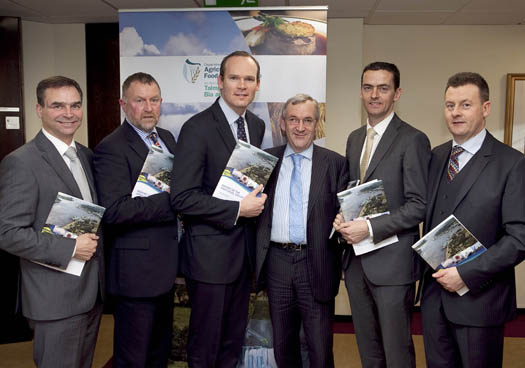
Minister for Agriculture, Food and the Marine, Simon Coveney with Sean O'Donoghue, Chairman, Chief Executive, Killybegs Fishermen's Organisation Ltd, Cecil Beamish, Assistant Secretary, Department of Agriculture, Food and the Marine, Seamus Neely, County Manager, Donegal County Council, Jason Whooley, Chief Executive, Bord Iascaigh Mhara (BIM), Paul Hannigan, President, Letterkenny Institute of Education, Jim Parkinson, Representing Offshore and Ancillary Services, Niall O'Gorman, Representing Donegal Fish Merchants Association and Conor Fahy, Regional Director, Enterprise Ireland at the launch of a report on Job Creation in the Killybegs Region.
Minister Coveney commented at the launch; "I set ambitious targets for the group and I am very pleased to see that the group has not only clearly outlined how 250 jobs can be achieved but has also identified new areas where additional jobs can be created into the future. The importance of the seafood sector to Killybegs region cannot be overstated as it is responsible for 68% of the workforce. The Group has identified that through greater diversification and adding value to our existing resources, 130 jobs will be delivered in this sector. The Group are to be commended for working together to complete this task in the allocated time and I am looking forward to seeing the actions from the report completed and the benefits that they will bring to the people of Killybegs".
The report outlines 250 jobs to be created over a three year period across five key areas. In total, 130 potential jobs were identified within the seafood sector. The expected increased access to raw materials such as blue whiting and boarfish present the most significant opportunities, along with a concerted focus on value adding opportunities. Within the ancillary services, 24 jobs were identified if collaborative opportunities between various companies can be enhanced and their abilities promoted. The offshore sector could generate 20 jobs, however competitive service provision and appropriate skill resources are deemed fundamental to achieve this. Approaching 50 jobs were identified within the tourism/marine leisure area if a co-ordinated marketing strategy is developed, whilst the green economy and renewable energy area offers the potential to create up to 40 jobs.
The Minister added "This pilot approach of co-ordinated developmentally focused activity which is concentrated on natural resources has delivered results that will drive economic development and job creation in the Killybegs region. An example of this is the partnership between BIM and LYIT to address seafood value added activities. As a direct result of this jobs initiative, the College of Catering in Killybegs will become a focus for industry activity beginning with a workshop on new product development for crab suppliers is already planned for the 30th November".
Members of the High Level Group are:
Sean O'Donoghue, Chairman, Chief Executive, Killybegs Fishermen's Organisation Ltd
Cecil Beamish, Assistant Secretary, Department of Agriculture, Food and Marine
Seamus Neely, County Manager, Donegal County Council
Jason Whooley, Chief Executive, Bord Iascaigh Mhara (BIM)
Paul Hannigan, President, Letterkenny Institute of Education
Jim Parkinson, Representing Offshore and Ancillary Services
Niall O'Gorman, Representing Donegal Fish Merchants Association
Conor Fahy, Regional Director, Enterprise Ireland
Galway Hooker En Route to Abu Dhabi in VOR Cultural Exchange
A traditional Irish sailing boat is on the way to Abu Dhabi in a cultural exchange that will also see six Arabian dhows in Galway for the finish of the Volvo Ocean Race next summer.
The National reports that the near-century-old Galway hooker Nora Bheag is being transported to the United Arab Emirates as part of a Maritime Heritage Cultural Exchange initiative, co-ordinated by Irish expat Peter Vine. (Track its progress at marinetraffic.com.)
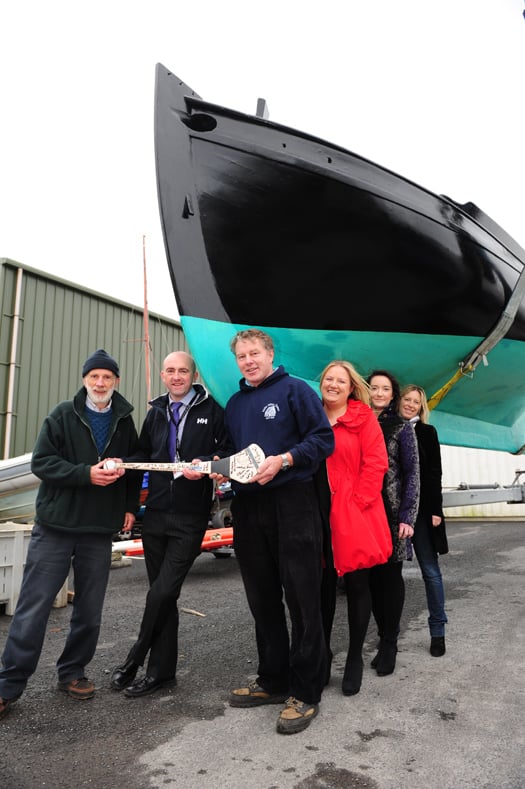
On her way: Nora Bheag heads for Abu Dhabi. Photo: Boyd Challenger
According to the Galway Independent, the boat is currently en route to Rotterdam in a container loaded with a small curach named Noa.
Plans to include turf and bottles of poitin were abandoned, however, due to customs concerns - instead two hurleys and a sliotar will make the trip.
Nora Bheag is expected to reach port by early December ahead of the Volvo Ocean Race fleet which arrives on 1 January, marking the first time the city has hosted and taken part in the race.
Vine says he came up with the idea of the boat swap because of the two countries' shared maritime heritage.
There are many similarities between hookers and dhows, too, from their comparable sail shapes to their usage for fishing and personal transport.
"This will be a huge common shared experience that will build true friendships and a real cultural exchange," said Vine. "I am hugely grateful to Emirates Heritage Club, which has done so much to revive Arabian dhows, for making such a project possible."
The National has more on the story HERE.
Meanwhile a delegation from Galway is set to travel to Spain later this week for the launch of the Volvo Ocean Race.
A week of events begins this Saturday ahead of the start of the race proper on 5 November in Alicante.
National Maritime College Open its Doors
Situated on the shores of Cork Harbour this magnificent facility has both a National and International reputation with students from as far away as the United Arab Emirates. For the Open Day, representatives from International Shipping Companies and Maritime Organisations will be available on site to provide information about careers in the industry.
There will be tours of the College, including the multi-million euro shipping simulators, sea survival centre and engineering workshops.
Details on course opportunities at the NMCI will be available at the Open Day – Tuesday, October 25th. For further information please contact phone 021 4970607
Dr John de Courcy Ireland Remembered at Connemara Maritime Festival
Ireland's leading maritime histortian will be remembered during Conamara Sea Week, which starts next Friday.
The 10-day programme celebrating the west of Ireland's rich maritime heritage kicks off just two days after the centenary of the late Dr John de Courcy Ireland, who tirelessly documented Ireland's relationship with the sea in parallel with a distinguished career as a political activist.
According to The Irish Times, he will be remembered during a conference on 'The Sea as Inspiration' on Saturday 29 October in Letterfrack, Co Galway.
Education and arts are major themes of the maritime festival, which will also feature an exhibition of works from emerging artists.
For more details visit the website of the Conamara Environmental Educational and Cultural Centre at ceecc.org.





























